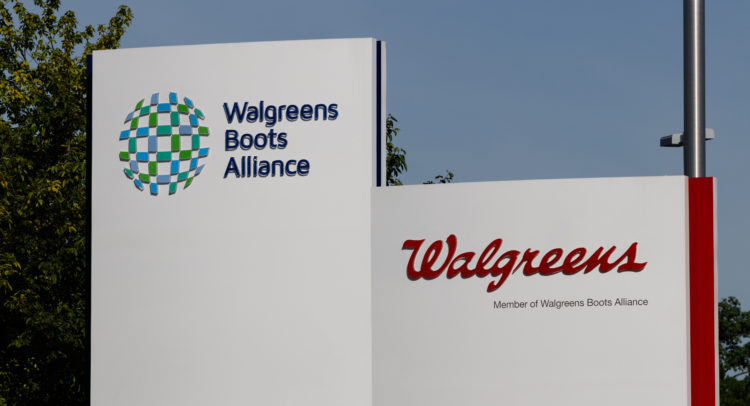Illinois-headquartered Walgreens Boots Alliance (WBA) operates retail pharmacies in the U.S. and internationally. I am bullish on the stock.
Elevate Your Investing Strategy:
- Take advantage of TipRanks Premium at 55% off! Unlock powerful investing tools, advanced data, and expert analyst insights to help you invest with confidence.
Along with the usual litany of challenges in 2022 – high inflation, supply-chain woes, shortages of workers, and so on – Walgreens can add one more to its list. In particular, the circumstances that gave Walgreens a major boost in 2020 and 2021 don’t exist today, or at least not to the same extent.
While the COVID-19 pandemic certainly isn’t finished yet, the demand for COVID-19 tests and vaccines has undoubtedly declined this year in comparison to 2020 and 2021. As we’ll see, there’s even been a steep drop-off in demand for these products over the past couple of quarters.
Yet, this is a known factor and any recently reported fiscal results should be viewed in the context of these challenges. Thus, after sifting through the data with a fair and objective perspective, you might find that Walgreens is faring surprisingly well and the critics’ negative sentiment is unjustified.

On TipRanks, WBA scores a 7 out of 10 on the Smart Score spectrum. This indicates a potential for the stock to perform in-line with the broader market.
A Dose of Reality
Make no mistake about it: Staying in the trade with Walgreens stock hasn’t been easy this year. Believe it or not, the share price started in early January at around $53, only to tumble below $40 in recent days.
That’s rough, but it does open the door to opportunities for prospective investors. Consider that Walgreens’ trailing 12-month P/E ratio is just 5.62. This should make value-focused traders salivate. Plus, income investors ought to appreciate Walgreens’ generous forward annual dividend yield of 5.04%. What more could anyone ask for?
Okay, I suppose you could ask for the company to demonstrate its value proposition through top- and bottom-line growth. That’s a tall order, though, during a time when COVID-19 vaccination rates have declined. According to The Wall Street Journal, Walgreens administered 11.8 million vaccine doses during fiscal 2022 second quarter – back when the Omicron COVID-19 variant strain prompted more folks to get shots.
Fast-forward to the third quarter, and Walgreens only administered 4.7 million vaccine shots during this time. That’s already a problem for the company, and we can add elevated inflation rates into the mix. Amid this worrisome backdrop, it might seem like people aren’t going to purchase health/wellness products from Walgreens anymore.
Walgreens CEO Roz Brewer evidently takes a different view, though. “We see our customers making deliberate choices to prioritize overall value and convenience,” Brewer observed, adding, “There’s a shift in calculus due to food and fuel inflation, but health and wellness will always be a priority.”
Of course, it’s part of a CEO’s job description to stay positive and rally the troops when times get tough. Ultimately, it’s the data that separates the hype from the truth. So, what does the data tell us about Walgreens’ financial and operational status now?
Missing, yet also Beating
During Q3 of FY2022, Walgreens clearly felt the impact of reduced vaccine and testing-kit sales. Thus, the company’s quarterly sales from continuing operations decreased 4.2% compared to the year-ago quarter, to $32.6 billion. However, this result represented a slight beat compared to the analysts’ consensus call for $32.06 billion. Hence, it’s not a such terrible result.
Turning to the top line, Walgreens posted Q3 FY2022 adjusted EPS from continuing operations of 96 cents, down 30% year-over-year on a reported basis. Again, though, there’s a positive way to spin this result as it beat the analysts’ consensus estimate of 92 cents per share.
Here’s the real kicker, though. If the skeptics thought that Walgreens is stagnating as a provider of health and wellness products/services, they need to reconsider. As it turns out, the Walgreens Health segment reported third-quarter sales of $596 million. According to the company, “On a pro forma basis, compared to their year-ago standalone results, these [Walgreens Health] businesses grew sales at a combined rate of 65 percent in the quarter.”
Moreover, VillageMD grew 69%, “reflecting existing clinic growth and footprint expansion.” Hence, while the customers aren’t coming to Walgreens for COVID-19 shots nearly as often as they used to, they still count on Walgreens for various health-and-wellness needs.
Besides, The Wall Street Journal reported that Walgreens is adding “hundreds” of primary-care offices while also expanding into home healthcare. This sounds like a company that’s growing fast, and not a business that’s struggling because the customers aren’t getting COVID-19 vaccinations.
Wall Street’s Take

According to TipRanks’ analyst rating consensus, WBA is a Hold, based on one Buy, nine Hold, and one Sell ratings. The average Walgreens Boots Alliance price target is $46, implying 19.29% upside potential.
The Takeaway
It’s easy to find valid reasons to invest in Walgreens, if you’re willing to look for them. First of all, the company pays an enticing dividend and Walgreens stock is trading at a low valuation multiple.
Furthermore, the company is demonstrating impressive strength in its Walgreens Health businesses. If Walgreens managed to achieve this despite a slowdown in COVID-19 testing and vaccinations, then that’s bullish for both the company and the stock, and investors can consider a long position today.
Read full Disclosure
















